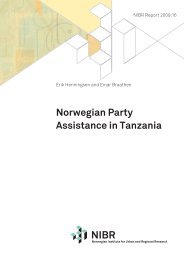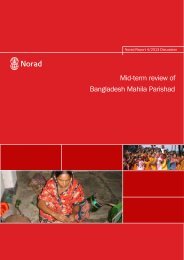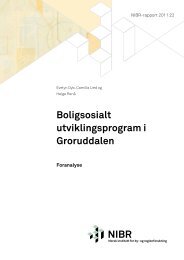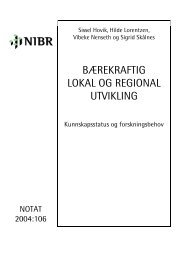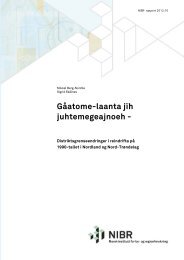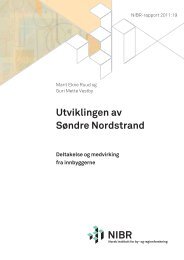http://www.tandfonline.com/page/terms-andconditions
The special importance of housing policy for ethnic minorities ...
The special importance of housing policy for ethnic minorities ...
- No tags were found...
You also want an ePaper? Increase the reach of your titles
YUMPU automatically turns print PDFs into web optimized ePapers that Google loves.
International Journal of Housing Policy 5Downloaded by [Norsk Institutt for By og] at 07:07 11 March 2013for high-in<strong>com</strong>e groups, while only low-in<strong>com</strong>e groups can get housing allowances inrental housing. Segmentation can also result from the way access to tenures is regulated.Sometimes only low-in<strong>com</strong>e groups can access subsidised social/public housing.In this article, the housing out<strong>com</strong>es of immigrants are characterised by two measures.The first is the immigrants’ achieved position in housing tenures <strong>com</strong>pared with that of thewhole population. This is called the ‘ethnic segmentation of the housing market’.The housing market segmentation of immigrants gives a picture of to what extentimmigrants have easy or difficult access to different housing tenures, especially to homeownershipand social/public housing. Particularly in American literature on the processesof integration (assimilation) of immigrants (Borjas, 2002; Alba & Nee, 1997), homeownershipis often seen as a sign of positive social integration. In this light a high segmentationof immigrants, resulting in a higher representation in rental housing, could be seen as a signof weak integration and failed integration policies. Another negative aspect related to highsegmentation is that different tenures tend to be concentrated in different neighbourhoods.High segmentation can therefore result in higher segregation of immigrants and concentrationin low-cost tenures, often social/public housing in particular neighbourhoods (SkifterAndersen, Andersen, & Ærø., 2000).The second measure used in this article to <strong>com</strong>pare immigrants’ housing positionbetween the four Nordic countries is the proportion of immigrants living in overcrowdeddwellings <strong>com</strong>pared with the whole population. This ‘relative overcrowding’ is a measureof to what extent the housing consumption, which immigrants have obtained, differs fromthe general level of the countries.In the final analysis, our focus is on how the differences in ethnic segmentation andrelative overcrowding between the countries can be explained by differences in housingpolicies, housing markets and housing stocks. We distinguish between conditions thatincrease or decrease the housing options of low-in<strong>com</strong>e groups, and conditions that havea special significance for immigrants beside the effects for low-in<strong>com</strong>e groups. We tryto find explanations for differences in overcrowding and why immigrants are over- orunderrepresented in different tenures in the countries by looking at specific elements oftheir housing policies. We also examine whether the differences between immigrants’housing position in the various countries can be explained by differences in the position ofin<strong>com</strong>e groups.The data used in the article <strong>com</strong>e from many different statistical sources and it hasnot been easy to obtain <strong>com</strong>parable data. The sources of the data are specified withinrelevant tables. Some of the data have been collected in connection with the NODESproject (Andersson et al., 2010); other data have been collected separately from nationalstatistical offices. Data on homeownership rates in in<strong>com</strong>e groups stems from an EU survey.Immigration to the four Nordic countriesIt has been demonstrated in several studies that different ethnic groups can have varyinghousing preferences and perform differently on the housing market (Skifter Andersen 2012).There are differences especially between immigrants <strong>com</strong>ing from Western countries andthose <strong>com</strong>ing from non-Western countries. When in the following sections we look atexplanations for differences between the four Nordic countries, it is therefore important tobe aware of the differences in the immigration to the countries.As described in Andersson et al. (2010), there are some important distinctions in thenature of the immigration to the four Nordic countries. The extent of immigration varies,



